Info
Subfamily: Pooideae
Genus etymology: Polypogon = "several beard" [Greek] refering to the bristly glumes
Species etymology: monspeliensis = from Montpellier, France
Photosynthetic type: C3 (cool season)
Nativity: naturalized - accidental
First recorded in Hawaiʻi: 1909
Map
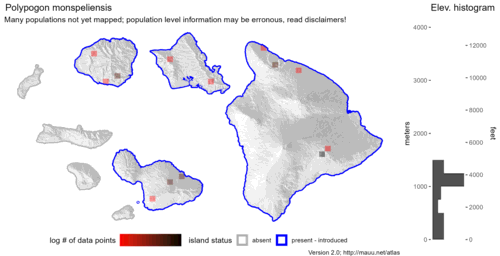
Inflorescence
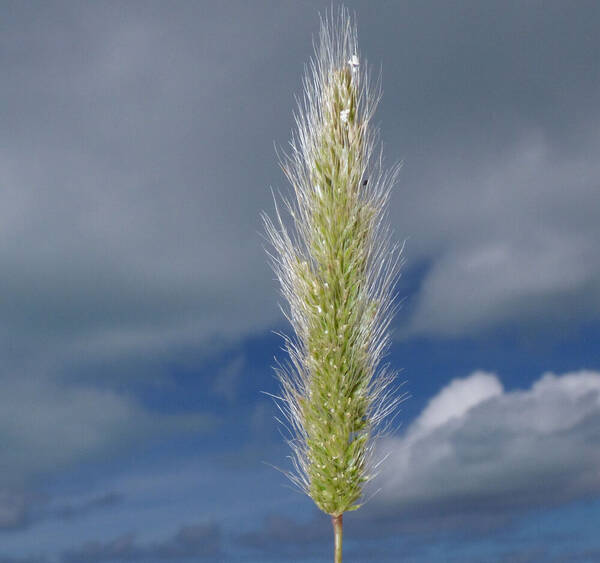 image credit: Forest & Kim Starr
image credit: Forest & Kim StarrPlant
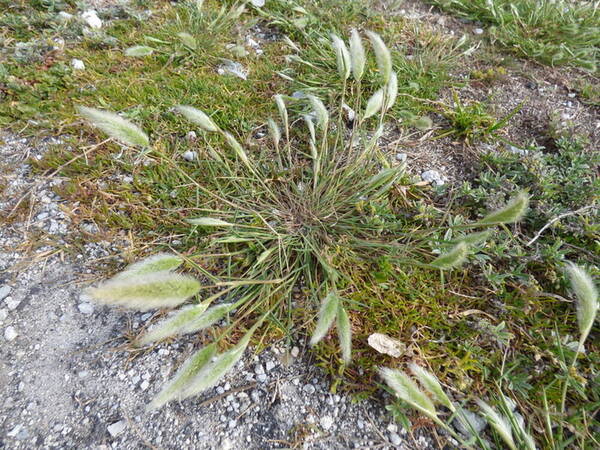 image credit: Forest & Kim Starr
image credit: Forest & Kim StarrHabit
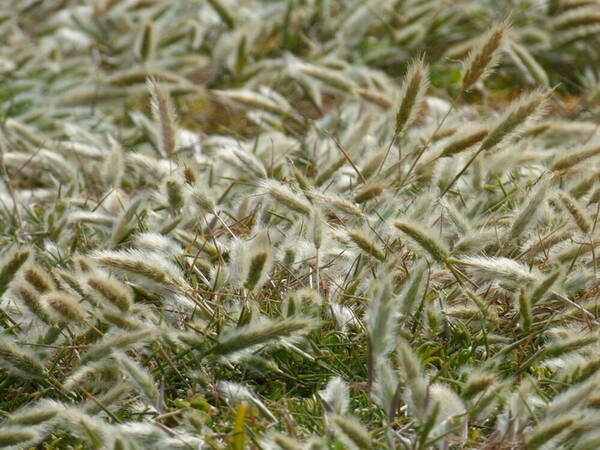 image credit: Forest & Kim Starr
image credit: Forest & Kim StarrSpikelets
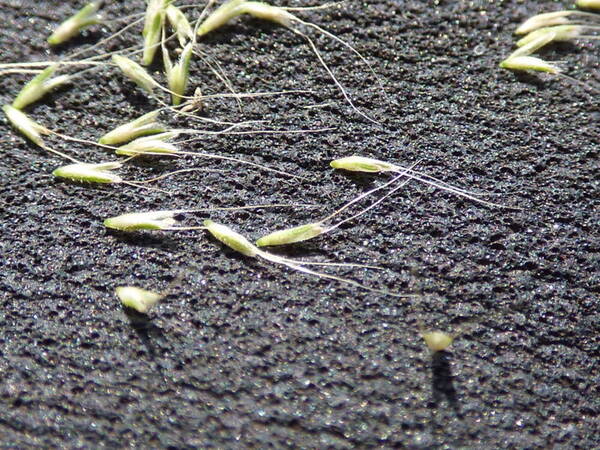 image credit: Forest & Kim Starr
image credit: Forest & Kim StarrDescription
Annual; culms 6–80 cm. high, in small tufts or solitary, erect or geniculate at the base. Leaf-blades 5–20 cm. long and 2–8 mm. wide, rough; ligule 3–15 mm. long. Panicle narrowly ovate to narrowly oblong, cylindrical or lobed, 1.5–16 cm. long and 1–3.5 cm. wide, very dense and bristly, pale green or yellowish. Spikelets narrowly oblong, 2–3 mm. long, falling with a minute piece of the pedicel; glumes slightly notched at the apex, rough with minute points especially in the lower part, minutely hairy on the margins, with a fine straight awn 4–7 mm. long; lemma about half the length of the glumes, smooth, awnless or with an awn up to 2 mm. long. Fig. 33, p. 99.
(Description source: Clayton, W.D. 1970. Flora of Tropical East Africa. Gramineae (Part 1). Crown Agents for Oversea Governments and Administrations, London. 176 pp. )
Annual up to 80 cm high. Panicle narrowly ovate to narrowly oblong, cylindrical or lobed, 1.5–16 cm long, very dense and bristly. Spikelets 2–3 mm long; glumes slightly notched at the tip, scabrid below, minutely hairy on the margins, with a fine straight awn 4–7 mm long; lemma about 1/2 the length of the glumes, smooth, awnless or with an awn up to 2 mm long.
(Description source: Cope, T.A, (1995) Flora Somalia, Vol 4. Royal Botanical Gardens, Kew, London. 312 pp. )
A loosely caespitose rather variable annual. Culms 5-75(90) cm. tall, 2-6-noded, erect or ascending from a decumbent base, slender to somewhat stout, simple, glabrous, smooth or sometimes scaberulous towards the panicle. Leaf-sheaths longer (the lower) to shorter (the upper) than the internodes, usually loose, glabrous, smooth or scaberulous towards the mouth. Ligule 3-15 mm. long, oblong, often lacerate, dorsally asperulous. Leaf-laminae 2.5-15(20) x 0.2-0.9 cm., lanceolate-linear to linear, tapering to an acute point, usually expanded, flaccid to somewhat rigid, scaberulous along the nerves on both surfaces or smooth on the lower surface. Panicle 1.5-16 cm. long, very dense, spike-like, bristly, cylindrical or often lobed, compact, rarely interrupted, pale-green or yellowish, rarely brownish; branches obliquely ascending to almost appressed to the rhachis, divided from the base. Lateral pedicels rather short, disarticulating about the middle. Spikelets 2-3 mm. long (excluding the awn). Glumes 1-2 mm. long (excluding the awn), subequal, narrowly oblong, dorsally scabrous, with the obtuse apex minutely 2-lobed; awn 4-7.5 mm. long, scaberulous. Lemma c. 1/2 the length of the glumes (excluding the awn), broadly elliptic with the apex minutely dentate; awn (if present) 1.5-2.5 mm. long. Anthers c. 0.5 mm. long, oblong. Caryopsis c. 1 mm. long.
(Description source: Launert, E. & Pope, G.V. (eds.). 1989. Flora Zambesiaca. Volume 10. Part 3. Kew, London. 152 pp )
Plants annual. Culms 5-65 (100) cm, erect to geniculately ascending. Sheaths glabrous, the uppermost sheaths sometimes inflated; ligules 2.5-16 mm; blades 1-20 cm long, 1-7 mm wide. Panicles 1-17 cm, narrowly ellipsoid, dense, sometimes lobed, greenish; pedicels absent or to 0.2 mm; stipes 0.1-0.2 mm. Glumes 1-2.7 mm, hispidulous throughout, largest prickles restricted to the lower 1/2, apices rounded, lobed, lobes 0.1-0.2 mm, 1/10 or less the length of the glume body, awned from the sinus, awns 4-10 mm, yellowish; lemmas 0.5-1.5 mm, glabrous, awned, awns 0.5-1(4.5) mm; paleas subequal to the lemmas; anthers 0.2-1 mm. 2n = 14, 28, 35, 42.
(Description source: Barkworth, M.E., Capels, K.M. & Long, S. (eds.) 1993. Flora of North America, north of Mexico. Volume 24. Magnoliophyta: Commelinidae (in part): Poaceae, Part 1. Oxford University Press, New York. 911 pp. http://floranorthamerica.org/Polypogon_monspeliensis )
Annuals; culms tufted, often decumbent at base and rooting at nodes, 0.3-4(-8) dm tall. Sheaths smooth to scaberulous; ligule 2-6(-12) mm long, puberulent, apex acute, lacerate, lateral margins splitting into auricle-like segments; blades usually flat, 1.5- 5(-12) mm wide, glabrous to scaberulous. Panicles 1-6.5(-10) cm long, compact, branches short, appressed to ascending; glumes subequal, narrowly elliptic, 1.5-2.5 mm long, keel and margins scabrous to hispidulous, especially toward base, awned from between rounded lobes of a bifid apex, the awn (4-)4.5-9.5(-10) mm long; lemma ca. the length of the glumes, 0.7- 1.2 mm long, ovate, smooth and glossy, apex minutely bifid, awn absent or very short and straight; palea nearly as long as lemma. Caryopsis pale brown, fusiform to narrowly ovoid, 0.8-1 mm long. [2n = 14, 28, 35.]
(Description source: O’Connor, P.J. 1990. Poaceae, pp. 1481–1604. In: Wagner W.L., Herbst D.R. & Sohmer S.H. (eds.)., Manual of the flowering plant of Hawaiʻi. Vol. 2. University of Hawaii Press & Bishop Museum Press, Honolulu )